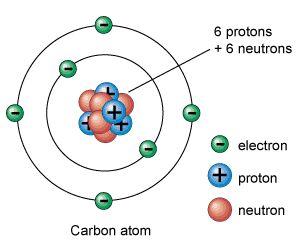[/caption]The image on the left is a basic atom diagram. This one shows the protons, neutrons, and electrons of a carbon atom. Each is in a group of six. That makes the atom very stable. There have been many atomic models over the years, but this type of model is now widely considered a sound basic version. Atomic diagrams were developed to explain the interaction of the elements of the Earth and space long before atoms could be observed. Nowadays, scientists can see particles that are smaller than an atom. These sub-atomic particles are the basis of particle physics.
Scientists have used atomic diagrams to explain the workings of the world for centuries. The ancient Greeks and, before them, the Chinese and Babylonians believed that there were forces that could not be seen that allowed certain metals to be combined and worked to man’s advantage. They did not know it, but that was simply heated metals exchanging subatomic particles to become a new metal.
Basic chemistry explains the atom best. It states that the fundamental building block of matter is the atom. An atom consists of three main parts: protons, neutrons, and electrons. Protons have a positive electrical charge. Neutrons have no electrical charge. Electrons have a negative electrical charge. Protons and neutrons are found together in what is called the nucleus of the atom. Electrons circle around nucleus. Chemical reactions involve interactions between the electrons of one atom and the electrons of another atom. Atoms which have different amounts of electrons and protons have a positive or negative electrical charge and are called ions. When atoms bond together, they can make larger building blocks of matter called molecules. If science did not have the atom modeled out, it would never have understood this exchange of electrons and we could still be stuck in the Dark Ages.
Earlier, I mentioned that there had been many atom models developed. Some of them are the Bohr model, the cubic model, the plum pudding model, the Saturnian model, and the Rutherford model.
Each of these models improved on the other and propelled science closer to a perfect atomic model. The Bohr and Rutherford models were developed for quantum mechanics and used for astronomical applications. As a matter of fact, an improvement on the Bohr model, called the Bohr-Summerfield model, is responsible for some of the many things we now know about quantum mechanics.
The atom diagram is under constant revision as science uncovers more information about sub-atomic particles. Follow this link to get information about the Bohr model and its enhancements. Here on Universe Today we have two great articles: one about the proton and the other about electrons. Astronomy Cast offers a good episode about matter from stars.
Sources:
Wikipedia
Chemistry Help

